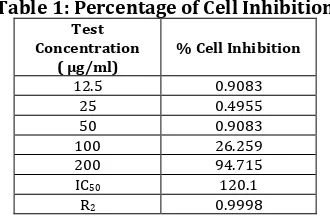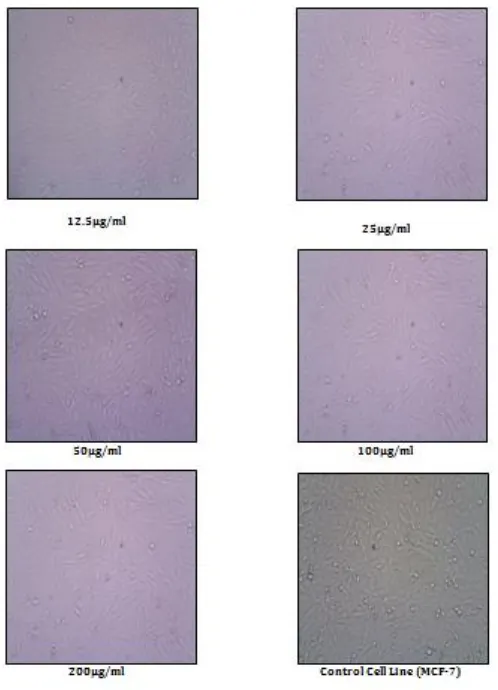INTERNATIONAL JOURNAL OF PHARMACEUTICAL, CHEMICAL AND BIOLOGICAL SCIENCES
Available online at
www.ijpcbs.com
EVALUATION OF
IN VITRO
ANTICANCER ACTIVITY OF ETHANOL AND
ETHYL ACETATE EXTRACTS OF
ALBIZIA SAMAN
FLOWERS
R. Murali, A. Anton Smith
*, S. Parimalakrishnan,
G. Jelin Jaralda and N. Vinothini
Department of Pharmacy, Annamalai University,
Annamalai Nagar-608 002, Tamil Nadu, India.
INTRODUCTION
Albizia saman formerly called Samanea saman (Leguminosae; family), a fast budding tree normally used as pasture for ornamental purposes. The flowers, bark, leaves, roots, seeds and pods of the tree are so far used as medicine from the traditional system1. The alcoholic extract of selected leaves inhibit Mycobacterium tuberculosis the alkaloid portion of leaves is active on CNS and as laxative. Seeds are masticated for stinging throat. A decoction from the fresh leaves and inner bark are used for colds, diarrhea, and intestinal problem2. The literature reveals that Albizia saman contains alkaloids, glycosides, terpenoids etc., the extracts of flowers possess antioxidant activity3. The tiny flowers (12–25 per head) are massed in pinkish heads 5-6 cm (2-2.4 inch) across and about 4 cm (1.6 inch) in height4. The mature pods of Albizia saman are black brown, almost oblong, clumpy, 10 to 20 cm long, 15 to 19 mm wide, 6 mm thick, slightly curved, eventually cracking irregularly, and filled with brownish pulp which is sticky, sweet and edible. The
bottom most line is that pods of Albizia saman tree which are rarely used as a plant source for herbs. Knowledge on phytochemical constituents of plant parts is mandatory in understanding the basis for any therapeutic effect. Recently, isolated flavonoids were reported to exhibit anti-carcinogenic activity. In addition to that the flavonoids through their free-radical scavenging activity have multiple biological functions including vasodilatory, anti-microbial, anti-inflammatory, anti-bacterial, immune stimulatory, anti-allergic and anti-viral functions2.
Cancer is a disease that has always been a major threat and has been characterized by proliferation of abnormal cells5. There are 200 different types of cancer that of list humans (Cancer Research UK). Cancer is commonly defined as the uncontrolled growth of cells, with loss of differentiation and commonly with metastasis, spread of the cancer to other tissues and organs. Cancers are malignant growths, where as in contrast, benign growths remain encapsulated and grow within a well defined
Research Article
ABSTRACT
To evaluate in vitro anticancer activity on the MCF-7 cell line (Human breast cancer cell line) of Albizia saman (Leguminosae: family) flower extract. The monolayer cells were detached with trypsin-ethylene diamine tetra acetic acid (EDTA) to make single cell suspension and viable cells were counted using a hemocytometer. The cell suspension was diluted with medium containing 5% FBS (Fetal Blood Serum) to obtain final density of 1x105cells/ml. 100µl per well of cell suspension were seeded into 96-well plates at plating density of 10,000 cells/well and incubated to allow for cell attachment at 370C, 5% CO2, 95% air and 100% relative humidity. The results obtained from the in vitro studies performed using the human breast cancer cell line (MCF-7) reveals that the ethanolic extract of Albizia saman flower has a moderate anticancer activity with 94.72% growth inhibition at 200µg/ml. The IC50 value was 120.1µg/ml and the regression value was 0.999.
area. The causes of cancer are diverse, complex, and only partially understood. Cancer is classified by the type of cells that the tumor cells resemble and are therefore presumed to be the origin of the tumor. Though chemotherapy is now being used as a standard treatment method, search for anti-cancer agents from natural products has increased.
The prevalence of breast cancer in Indian women is more at the age of forty6. The incidence of breast cancer has been increasing worldwide for many decades7 with Asian countries attaining highest incidence rate8. Some breast tumors stay resistant to conventional treatment9,10 and may have many side effects which affect the quality of the treatment11. According to the data of world Health organization, chemotherapy is needed for more than 90% of people affected with breast cancer. Hence we selected the flower of Albizia saman to treat the cancer cells which may not have significant side effects.
MATERIALS AND METHODS Plant collection and identification
The fresh Albizia saman flowers were collected from Annamalai Nagar, Chidambaram during the month of January to March. Selected samples were taxonomically identified and authenticated by Botanical Survey of India (BSI), Palayamkottai, Tirunelveli District.
Processing of plant materials
The flowers of Albizia saman were cleaned, shade dried, segregated, pulverized by a mechanical grinder and passed through a Sieve
#40. The powdered plant materials were stored in a clean air tight container until needed for analysis with proper labelling.
Preparation of plant extracts Solvent extraction
Crude plant extract was prepared by Soxhlet extraction method. The flowers were shade
Evaluation of in vitro anticancer activity Cell line
The human breast cancer cell line (MCF-7) was obtained from National Centre for Cell Science (NCCS), Pune and grown in Eagles Minimum Essential Medium (EMEM) containing 10% fetal bovine serum (FBS). The cells were maintained at 370C, 5% CO2, 95% air and 100% relative humidity and the culture medium was changed twice a week5.
Cell treatment procedure
The monolayer cells were detached with trypsin-ethylene diamine tetra acetic acid (EDTA) to make single cell suspension and viable cells were counted using a hemocytometer. The cell suspension was diluted with medium containing 5% FBS to obtain final density of 1x105 cells/ml. 100µl per well of cell suspension were seeded into 96-well plates at plating density of 10,000 cells/well and incubated to allow for cell attachment at 370C, 5% CO2, 95% air and 100% relative humidity. After 24 hours the cells were treated with serial concentrations of the test samples5.
They were initially dissolved in dimethyl sulfoxide (DMSO) and an aliquot of the sample solution was diluted to twice the desired final maximum test concentration with serum free medium. Additional four serial dilutions were made to provide a total of five sample concentrations. Aliquots of 100 µl of these different sample dilutions were added to the appropriate wells already containing 100 µl of medium, resulting in the required final sample concentrations. Following sample addition, the plates were incubated for an additional 48 hours at 37oC, 5% CO2, 95% air and 100% relative humidity. The medium containing without samples were served as control and triplicate was maintained for all concentrations5.
MTT Assay
(PBS) was added to each well and plates were incubated at 370C for 4 hours. The medium with MTT was then flicked off and the formed formazan crystals were solubilized in 100µl/well of DMSO and then the absorbance was measured at 570 nm using Micro plate reader. The effect of the samples on the proliferation of MCF-7 cell lines can be expressed as % cell viability or % cell growth. The percentage cell growth was then calculated with respect to control as follows
% Cell Growth = ([A] Test / [A]control) x 100
The % Cell inhibition was determined using the following formula
% Cell Inhibition = ((100- [A] Test) /[A] control) x 100
Where, [A] - Absorbance at 570 nm
Non-linear regression graph was plotted between % Cell inhibition and Log concentration (Figure 3). IC50 was determined using graph Pad Prism software.
RESULTS AND DISCUSSION
The results of cell growth inhibition by the plant extract against human breast cancer cell line
(MCF-7) for various concentrations are shown in Table 1. As the concentration increases there is an increase in the cell growth inhibition, but it is found to be very moderate with only 94.72% growth inhibition at 200µg/ml. The IC50 value was 120.1µg/ml and the regression value was 0.999.
Effect of ethyl acetate and ethanolic extracts of Albizia saman flower in various concentrations for anticancer activities were presented in Figure 1 and 2. The percentage of cell inhibition of the different extracts was presented in Figure 3. The results obtained were showed that the ethanolic extract of Albizia saman flower has a moderate anticancer activity.
CONCLUSION
The results obtained from the in vitro studies, which performed using the human breast cancer cell line (MCF-7) reveals that the ethanolic flower extract of Albizia saman has moderate anticancer activity. Even though there was an increase in the cell growth inhibition, when concentration of sample was increased, the IC50 value was more than 100µg/ml for cell line studies as shown by the MTT assay method. Hence the level of anticancer activity of the ethanolic extract of Albizia saman flowers can be concluded to be moderate effective.
Table 1: Percentage of Cell Inhibition
Test Concentration
( µg/ml) % Cell Inhibition
12.5 0.9083
25 0.4955
50 0.9083
100 26.259
200 94.715
IC50 120.1
Fig. 3: Percentage of Cell Inhibition Vs Log Concentration
0.0
0.5
1.0
1.5
2.0
2.5
0
20
40
60
80
100
Log
10
Concentration (g/ml)
%
Ce
ll
I
n
h
ib
it
io
REFERENCES
1. Thippeswamy S, Praveen P, Mohana DC and Manjunath K. Antimicrobial evaluation and phytochemical analysis of a known medicinal plant Samanea saman Merr. against some human and plant pathogenic bacteria and fungi, Int J Pharma Res Bio Sci. 2011;2(2):443-452. 2. Kirithika T. Preliminary phytochemical
screening and antioxidant property of various extracts of Albizia saman leaves, Int J Pharm Res Bio Sci. 2013;2(1):315-323.
3. Sundar M, Anton Smith A, Amutha Iswarya Devi J, Kottai Muthu A and Parimalkrishnan S. Phytochemical investigation and antioxidant activities of Albizia saman flowers. J Chem Pharm Sci. 2016;9(4):2952-2955.
4. Afia Ferdous, Mohammad Zafar Imam and Tajnin Ahmed. Antioxidant, Antimicrobial and Cytotoxic Activities of Samanea saman (Jacq.) Merr Stamf. J Pharm Sci. 2010;3(1):11-17.
5. Akhila Sravya D, Shankarguru P, Ramya Devi D and Vedha Hari BN. Evaluation of In vitro anticancer activity of hydroalcoholic extract of Tabernaemontana Divaricata. Asian J Pharm Clin Res. 2012;5(4):59-61. 6. Murthy NS, Agarwal UK, Chaudhary K
and Saxena S. A study on time trends in incidence of breast cancer-Indian
scenario. Euro J Cancer Care. 2007;16:185-186.
7. Hortobagyi GN, de la Garza Salazar J, Pritchard K, Amadori D, Haidinger R, Hudis CA, Khaled H, Liu MC, Martin M, Namer M, O'Shaughnessy JA, Shen ZZ and Albain KS. The global breast cancer burden: variations in epidemiology and survival. Clin Breast Cancer. 2005;6(5):391-401.
8. Green M and Raina V. Epidemiology screening and diagnosis of breast cancer in the Asia–Pacific region: current perspectives and important considerations. Asian Pacific J Clin Oncology. 2011;4:5-13.
9. Higgins MJ and Baselga J. Targeted therapies for breast cancer. J Clin Invest. 2011;121(10):3797–803.
10. Premalatha B and Rajgopal G. Cancer an ayurvedic perspective. Pharmacol Res. 2005;51(1):19–30.
11. Deo SVS. Challenges in the treatment of breast cancer in developing countries. World J Clin Oncology. 2014;5(3):465-477.

